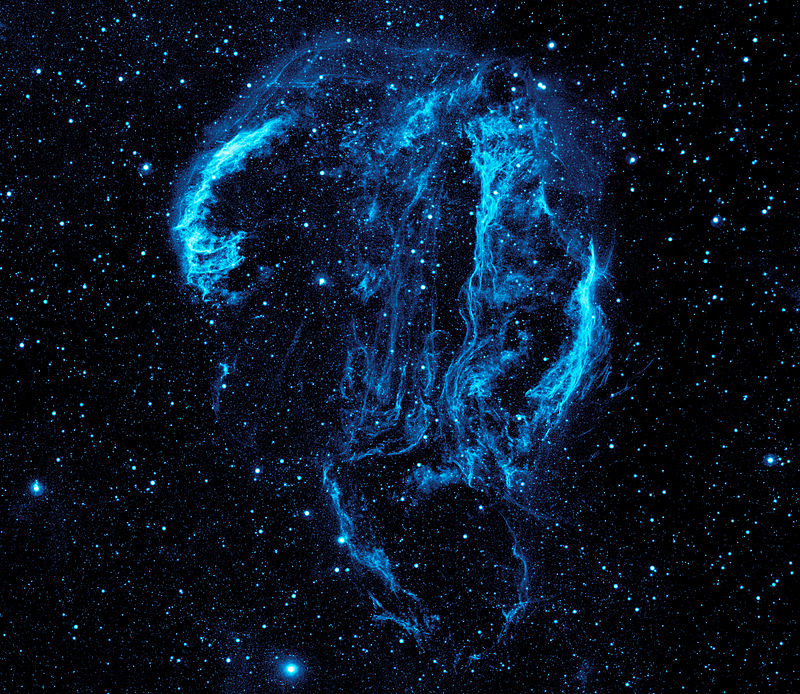Astronomy
 The Cygnus Loop is a giant supernova remnant. It is the remains of a star that exploded 8,000 years ago. The distance to it is estimated at about 2100 light years from Earth.
The Cygnus Loop is a giant supernova remnant. It is the remains of a star that exploded 8,000 years ago. The distance to it is estimated at about 2100 light years from Earth.
The visual portion of the Cygnus Loop is also known as the Veil Nebula.Because of its immense size, it contains several individually named objects, including NGC 6992 and IC 1340 on the left side as well as NGC 6960 and Pickering's Triangle on the right.
- The Tarantula Nebula.
The Tarantula Nebula, also known as 30 Doradus is a giant star-forming region, where energy from hot and young stars creates dramatic voids and filaments surrounding by gas. It is located in the Large Magellanic Cloud [LMC] galaxy at a...
- The Orion Nebula.
The Orion Nebula, also known as M42 or NGC 1976 is a diffuse nebula situated in the Milky Way, being south of Orion's Belt in the constellation of Orion. It is one of the brightest nebula and is visible to the naked eye in the night sky. ...
- The Firehead Supernova N 63a
It is estimated that the progenitor of the supernova that produced the remnant seen here was about 50 times more massive than our own Sun. Such a massive star has strong stellar winds that can clear away its ambient medium, forming a wind-blown bubble....
- The Pelican Nebula, Ic5067 And Ic 5070
The Pelican Nebula, IC5067 and IC5070, in the constallation Cygnus. With some imagination you can resemble a pleican in the red nebula. 1800 LY away from us. Celestron 80ED, 600 mm f7.5, piggyback on CPC11, 6x10 min ISO1600 with Canon 40D modified....
- M57 Ring Nebula In Lyra
The Planetary Nebula M57 is estimated to have exploded 20 000 years ago. The white dwarf in the middle (Magnitude 14) is surrounded by a darker space which is hotter than the visual ring. Since it so hot it does not emmit visual light but ultravioliet...
Astronomy
An Ultraviolet view of Cygnus loop.

The visual portion of the Cygnus Loop is also known as the Veil Nebula.Because of its immense size, it contains several individually named objects, including NGC 6992 and IC 1340 on the left side as well as NGC 6960 and Pickering's Triangle on the right.
- The Tarantula Nebula.
The Tarantula Nebula, also known as 30 Doradus is a giant star-forming region, where energy from hot and young stars creates dramatic voids and filaments surrounding by gas. It is located in the Large Magellanic Cloud [LMC] galaxy at a...
- The Orion Nebula.
The Orion Nebula, also known as M42 or NGC 1976 is a diffuse nebula situated in the Milky Way, being south of Orion's Belt in the constellation of Orion. It is one of the brightest nebula and is visible to the naked eye in the night sky. ...
- The Firehead Supernova N 63a
It is estimated that the progenitor of the supernova that produced the remnant seen here was about 50 times more massive than our own Sun. Such a massive star has strong stellar winds that can clear away its ambient medium, forming a wind-blown bubble....
- The Pelican Nebula, Ic5067 And Ic 5070
The Pelican Nebula, IC5067 and IC5070, in the constallation Cygnus. With some imagination you can resemble a pleican in the red nebula. 1800 LY away from us. Celestron 80ED, 600 mm f7.5, piggyback on CPC11, 6x10 min ISO1600 with Canon 40D modified....
- M57 Ring Nebula In Lyra
The Planetary Nebula M57 is estimated to have exploded 20 000 years ago. The white dwarf in the middle (Magnitude 14) is surrounded by a darker space which is hotter than the visual ring. Since it so hot it does not emmit visual light but ultravioliet...
